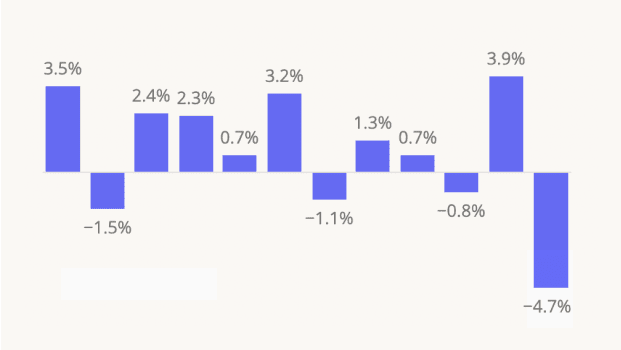About the Placer.ai Mall Index: The Placer.ai Mall Index analyzes data from 100 top-tier indoor malls, 100 open-air shopping centers (not including outlet malls) and 100 outlet malls across the country, in both urban and suburban areas. Placer.ai leverages a panel of tens of millions of devices and utilizes machine learning to make estimations for visits to locations across the country.
Mall Visits Rebound in March
Mall visits largely rebounded in March following their February drop. Traffic to indoor malls grew 1.8% year-over-year while open-air shopping centers and outlet malls saw their YoY visit gaps narrow to 1.1% and 0.7%, respectively. The rebound may be driven by the slight increase in consumer confidence among younger consumers (under 35 years old) and consumers from households earning over $125K a year – since affluent households are overrepresented in the trade areas of all three mall formats.
Indoor Malls Take the Lead
Indoor malls’ March YoY visit growth is the latest manifestation of the format’s strength. Between Q2 2023 and Q1 2024, open-air shopping centers led the shopping center space as this format consistently outperformed the other two mall types on a YoY visit basis. But over the past year, indoor malls have led the pack, with YoY visit trends to indoor malls consistently stronger than visitation metrics for the other two formats.
Some of the strength of indoor malls could be attributed to a sort of “survival of the fittest.” Many indoor malls shuttered in recent years, so the malls that remain in operation – such as the top-tier malls in the Placer.ai Indoor Mall Index – may be receiving some of the traffic that may have previously gone to less successful malls. Indoor malls are likely also benefiting from a renewed demand for the indoor mall experience – which could explain the string of recent investments in class B malls – from Walmart’s purchase of the Monroeville mall to Simon’s redevelopment of the Smith Haven Mall.
COVID’s Lingering Impact on Shopping Centers
March 2025 marked the five-year anniversary of the retail lockdowns. And although this past month marked an improvement in visitation trends on a YoY basis, zooming out in time reveals that the pandemic is still having a lingering impact on both the quantity and quality of mall visits across formats.
All three mall types received fewer, shorter visits in Q1 2025 compared to Q1 2019, with outlet malls seeing the largest drop in both visit numbers and visit duration. Open-air shopping centers experienced the strongest recovery in terms of visit numbers – Q1 2025 traffic was just 2.0% lower than in Q1 2019 – while visit duration fell 4.4%. Indoor malls saw the strongest rebound in visit duration, with Q1 2025 visits only 2.9% shorter than pre-pandemic – but visit numbers were down 7.4%. So despite the resilience of open-air shopping centers and the recent visit gains of indoor malls, the shopping center industry still has a ways to go before visitation patterns return to pre-COVID levels across the board.
As the industry looks beyond the five-year mark, the future of malls will likely depend on adaptability. Operators who can balance digital integration, experiential offerings, and responding to shifting consumer preferences will be best positioned to thrive in a post-COVID retail environment.
The Future of Malls
While the positive March visit data offers a degree of optimism for the mall industry, it's crucial to acknowledge that the sector is still navigating the long-term effects of the pandemic, characterized by fewer and shorter visits compared to pre-2020. At the same time, the recent success of indoor malls suggests a potential shift in consumer preferences or a concentration of traffic in stronger locations, highlighting the ongoing evolution of the retail landscape. Moving forward, the resilience and future success of malls will likely hinge on their ability to adapt to changing consumer behaviors and integrate innovative strategies that enhance the overall shopping experience.




.png)
.png)

.png)
.png)












.svg)